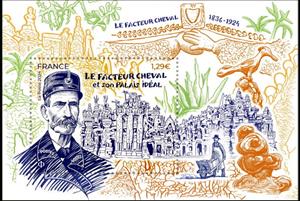Souvenir Sheet: Ferdinand Cheval, Postman and Amateur Architect (France 2024)
Ferdinand Cheval, Postman and Amateur Architect (France 2024)
22 April (France ) within release Ferdinand Cheval, Postman and Amateur Architect goes into circulation Souvenir Sheet Ferdinand Cheval, Postman and Amateur Architect face value 1.29 Euro
| Souvenir Sheet Ferdinand Cheval, Postman and Amateur Architect in catalogues | |
|---|---|
| Colnect codes: | Col: FR 2024.04.22-01 |
Souvenir Sheet is horizontal format.
Also in the issue Ferdinand Cheval, Postman and Amateur Architect:
- Souvenir Sheet - Ferdinand Cheval, Postman and Amateur Architect face value 1.29;
- Stamp - Ferdinand Cheval, Postman and Amateur Architect face value 1.29;
Souvenir Sheet Ferdinand Cheval, Postman and Amateur Architect it reflects the thematic directions:
An architect is a person who plans, designs, and oversees the construction of buildings. To practice architecture means to provide services in connection with the design of buildings and the space within the site surrounding the buildings that have human occupancy or use as their principal purpose. Etymologically, the term architect derives from the Latin architectus, which derives from the Greek (arkhi-, chief + tekton, builder), i.e., chief builder
An artist is a person engaged in an activity related to creating art, practicing the arts, or demonstrating an art. The common usage in both everyday speech and academic discourse refers to a practitioner in the visual arts only. However, the term is also often used in the entertainment business, especially in a business context, for musicians and other performers (although less often for actors). "Artiste" (French for artist) is a variant used in English in this context, but this use has become rare. The use of the term "artist" to describe writers is valid, but less common, and mostly restricted to contexts such as critics' reviews.
A castle (from Latin: castellum) is a type of fortified structure built in Europe and the Middle East during the Middle Ages by European nobility. Scholars debate the scope of the word castle, but usually consider it to be the private fortified residence of a lord or noble. This is distinct from a palace, which is not fortified; from a fortress, which was not always a residence for nobility; and from a fortified settlement, which was a public defence – though there are many similarities among these types of construction. Usage of the term has varied over time and has been applied to structures as diverse as hill forts and country houses. Over the approximately 900 years that castles were built, they took on a great many forms with many different features, although some, such as curtain walls and arrowslits, were commonplace.



